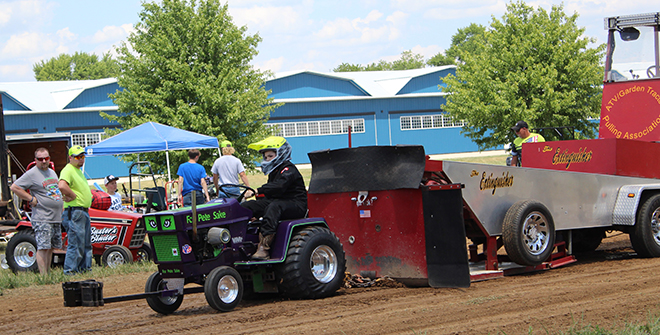Li’l Tractors, Big Pulls

A young contestant at the Garden Tractor Pull at the Poplar Grove Vintage Wings & Wheels Museum pits his tractor against the weight-bearing sled on the track.
By Anne Eickstadt
The Poplar Grove Vintage Wings & heels Museum hosted a garden tractor/ATV tractor pull on Saturday, July 3. The 53 contestants ranged in age from five-years-old to over 60-years-old.
Kaydra Heller, secretary/treasurer of the ATV/Garden Tractor Pulling Association, was the announcer for the event.
“This event features garden tractors and ATV vehicles,” said Heller. “Most of them will be Cub Cadets because the rear end is built stronger. Some of them have been modified with motorcycle engines. Our president, Brandon Heller, is driving the sled.”
Tractor pulling, also known as power pulling, is a competition that is popular in the United States, Canada, the Netherlands, Belgium, Denmark, and Germany, Australia, Brazil, and New Zealand, to pull a heavy drag (sled) along an 11-metre-wide (35 ft), 100-metre-long (330 ft) track, with the winner being the tractor that pulls the sled the farthest. The sport is known as the world’s most powerful motorsport, due to the multi-engine modified tractor pullers.
All tractors in their respective classes pull a set weight in the drag. When a tractor gets to the end of the track, this is known as a “full pull”. When more than one tractor completes the course, more weight is added to the drag, and those competitors that moved past 300 feet will compete in a pull-off; the winner is the one who can pull the drag the farthest. A monitor is installed in the sled which keeps track of the weight, distance, and velocity of the tractor. This monitor transmits the information to the person recording it on competition forms and the announcer.
The drag is known as a weight transfer drag. This means that, as it is pulled down the track, the weight is transferred (linked with gears to the drag’s wheels) from over the rear axles and towards the front of the drag. In front of the rear wheels, instead of front wheels, there is a “pan”. This is essentially a metal plate, and as the weight moves toward it, the resistance between the pan and the ground builds. The farther the tractor pulls the drag, the more difficult it gets.
Before the invention of the tractor, when farm implements were pulled by horses, farmers would boast about the strength of their teams and seek to compare and contest in teams with one another to see who had the most powerful animals. In some cases, they compared horse teams pulling large loads over distance, such as a fully loaded hay wagon. In other situations, a flat board or skid would have a horse or team of horses then hitched to it; weight would be added, usually in the form of rocks, and the driver would urge his horses to pull the load, with more weight added as competitors were eliminated; the animals pulling the most weight or for the greatest distance were judged the strongest.
It wasn’t until 1929 that motorized vehicles were put to use in the first events in Missouri and Ohio.
Although the sport was recognized then, it did not really become popular until the ’50s and ’60s. It was also realized, at that time, there were no uniform set of rules. The rules varied from state to state and county to county, and competitors never knew what standards to follow. This made the sport difficult for new entrants.
In 1969, representatives from eight states congregated to create a uniform book of rules to give the sport much needed structure, and created the National Tractor Pullers Association (NTPA). The NTPA’s early years were events that used standard farm vehicles.
This is the first time that the ATV/Garden Tractor Pulling Association have run an event at Vintage Wings & Wheels Museum. “We hope they will invite us back,” said Heller. “We have 10 booked events this year and our next pull will be in Wyoming on July 9. This is a family-friendly event. We can be found on Facebook.”


